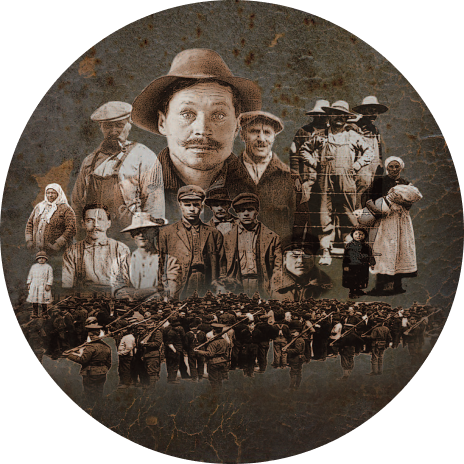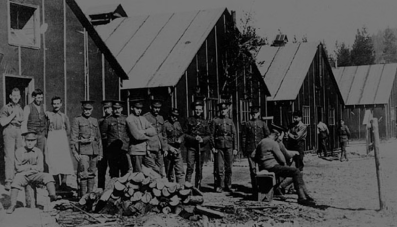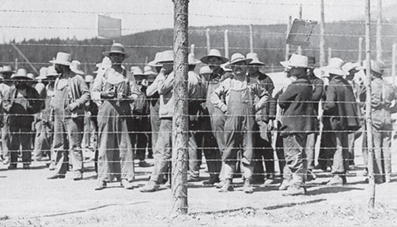About
“Project Roll Call represents the work of numerous organizations and individuals, and identifies the 7,000 men, women and children who were
interned in Canada during World War I.”
“Project Roll Call represents the work of numerous organizations and individuals, and identifies the 7,000 men, women and children who were
interned in Canada during World War I.”
Project Roll Call
During Canada’s first national internment operations from 1914-1920, Ukrainians and other Europeans were branded ‘enemy aliens’ and imprisoned unjustly in 24 internment camps throughout Canada. These so called “enemy aliens”, originated from countries at war with Canada and primarily included members of the Austro-Hungarian, German, and Ottoman empires as well as Bulgaria.
Tens of thousands of others were obliged to carry identity documents and report regularly to the police. Many were subjected to disenfranchisement, restrictions of their freedom of speech, movement, association, deportation, and the confiscation of what little wealth they had.
Project Roll Call represents the work of numerous organizations and individuals, and to date identifies the men, women and children who were interned in Canada during World War I.
The project was initiated in the late 1990s by the Ukrainian Canadian Civil Liberties Association together with Ihor Bardyn and the Canada Ukraine Parliamentary Program, and with the support of the offices of Inky Mark, M.P. (Dauphin-Swan River), and Myron Momryk, National Archives of Canada.
The current Project Roll Call was launched in February 2017 in continuation of the projects Roll Call: Lest We Forget and Roll Call Additions 2009. It has been made accessible with a grant from the Canadian First World War Recognition Fund (today the WWI Internment Legacy Fund).
To date, the project includes over 7,000 names, drawn from a broad network of internment camps, including those at Amherst, Banff, Beauport, Brandon, Castle Mountain, Edgewood, Fernie, Field, Halifax, Jasper, Kapuskasing, Kingston, Lethbridge, Mara Lake, Montreal, Morrissey, Munson, Nanaimo, Niagara Falls, Otter, Petawawa, Port Arthur, Revelstoke, Sault Ste. Marie, Spirit Lake, Sudbury, Toronto, and Vernon.
The archival documents associated with Project Roll Call reveal the diverse ethnicities of the internees, which include, but are not limited to, Albanian, Austrian, Bavarian, Bohemian, Bosnian, Bulgarian, Croatian, Czechoslovakian, Dalmatian, Danish, French, Galician, German, Greek, Armenian, Herzegovinian, Hungarian, Italian, Luxembourgian, Macedonian, Persian, Polish, Prussian, Romanian, Russian, Ruthenian, Serbian, Swiss, Transylvanian, Turkish, and Ukrainian.
These records not only document the camps in which these individuals were interned and their corresponding P.O.W. numbers but also provide detailed vital statistics, release or deportation dates, physical descriptions, and other important historical data.
Project Roll Call has benefitted from the contributions of numerous researchers and historians, including Jars Balan, Dr. Sarah Beaulieu, Cory Dvorak, Vivian Elgie, Frank Jankac, Dr. Bohdan Kordan, Dr. Lubomyr Y. Luciuk, Dr. Marinel Mandres, Peter Melnycky, Don McNair, Rev. Dr. Allan Miller, Mark Minenko, Sandra Semchuk, Daniel Ste-Marie, Natalka Yurieva, and Roman Zakaluzny. The project has also engaged a team of digitization specialists at Library and Archives Canada, as well as data entry personnel dedicated to transcribing information from archival records. The individuals who have worked in these roles are Brayden Bomba, Rachel Burgess, Jordynn D’angelo, Tyler Hunter, Christine LeMaire, Elena Plotnikoff, Rachel Romano, and Brian Wallin. Project Lead – Lawrna Myers.
The archives consulted for Project Roll Call span across Canada, the United States, and Europe, and include:
- Library and Archives Canada
- Archives of Ontario
- Institut Généalogique Drouin (Québec)
- Halifax Citadel and Municipal Archives
- International Committee of the Red Cross Historical Archives
- Manitoba Free Press (newspaper archives)
- National Archives and Records Administration (United States)
- National Archives of the United Kingdom
- Nova Scotia Archives and Historical Vital Statistics
- Provincial Archives of Alberta
- Royal BC Museum (British Columbia Provincial Archives)
- United States National Archives and Records Administration
The research and collaboration efforts aim to uncover, document, and preserve the stories of these individuals, ensuring their experiences during Canada’s First World War Internment Operations are remembered.
For more information on Canada’s first national internment operations and the work of communities to achieve recognition visit www.internmentcanada.ca.
Newspaper Indexing Project
In 2014, the Canadian First World War Internment Recognition Fund provided a grant to researcher and public historian Frank Jankac to undertake a newspaper indexing project that would provide a reference collection of digitized materials. The result is a readymade collection of articles culled from numerous Canadian newspapers which provides a good point of reference on this specific historical period in Canada’s history.
The collection also offers a comprehensive account of the existence of each camp and associated urban areas where existing article compilations are often very selective in scope. In addition to specific details related to the local context, internment can also immediately be placed within the national or international context.
Project 107 (aka Cemetery Project)
In 2015, the CFWWIRF awarded a grant to Lawrna Myers, Cemetery Researcher, to support Project 107, named for the initial number of deaths recorded in General William Otter’s report. However, further research revealed that a total of 124 men and children lost their lives during Canada’s First World War Internment Operations, across six provinces: British Columbia (18), Alberta (6), Manitoba (3), Ontario (59), Quebec (23), and Nova Scotia (15).
The objectives of Project 107 were as follows:
- To locate and document the individuals—both men, women, and children—who perished during the internment operations.
- To contact and verify the status of the 33 original cemeteries where the internees were buried, ensuring the remains are still in their original resting place.
- To install grave markers or plaques for those internees who currently lack a memorial.
- To place a monumental plaque on each internee’s marker, honoring their memory and contributions.





